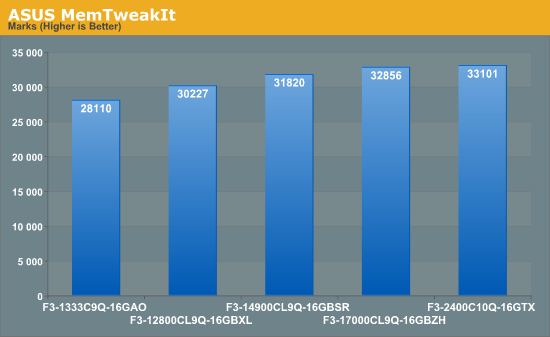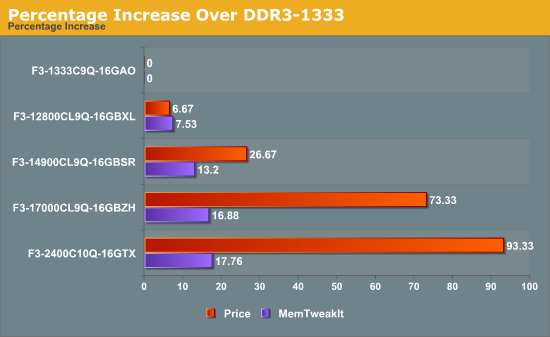Memory Performance: 16GB DDR3-1333 to DDR3-2400 on Ivy Bridge IGP with G.Skill
by Ian Cutress on October 18, 2012 12:00 PM EST- Posted in
- Memory
- G.Skill
- Ivy Bridge
- DDR3
Market Positioning
Over recent years the price of DDR3 memory kits has hit record lows quarter on quarter. This means that profit margins for companies are also getting smaller and smaller – it becomes hard to differentiate yourself as a product line on price alone. This is the reason why a lot of the kits we have looked at today are designed to be visually eye catching – having either colored heatsinks, detachable heatsinks or shaped designs.
The pricing for each of the kits are as follows:
$75: Ares DDR3-1333 9-9-9 4x4 GB
$80: RipjawsX DDR3-1600 9-9-9 4x4 GB
$95: Sniper DDR3-1866 9-10-9 4x4 GB
$130: RipjawsZ DDR3-2133 9-11-10 4x4 GB
$145: TridentX DDR3-2400 10-12-12 4x4 GB
The margin between the 1333 MHz and 1600 MHz kits is $5, and as such would only be differentiated between tight budget constraints, bulk sales or aesthetic looks. The jump up to 1866 MHz is slightly more, but going up to DDR3-2133 and beyond is a significant jump in price, indicative of the binning process required for these higher end modules. The testing in this review will show if the leap up to DDR3-2133 memory is proportionally a good idea.
Test Bed
| Test Bed | |
| Processor |
i7-3770K @ 4.4 GHz 4 Cores / 8 Threads |
| Motherboard | ASUS P8Z77-V Premium |
| Memory |
G.Skill 1333 MHz 9-9-9-24 1.5V 4x4GB Kit G.Skill 1600 MHz 9-9-9-24 1.5V 4x4GB Kit G.Skill 1866 MHz 9-10-9-28 1.5V 4x4GB Kit G.Skill 2133 MHz 9-11-10-28 1.65V 4x4GB Kit G.Skill 2400 MHz 10-12-12-31 1.65V 4x4GB Kit |
| CPU Cooler | Intel Stock Cooler |
| Graphics Cards |
Intel HD4000 ECS GTX580 |
| Power Supply | Rosewill SilentNight 500W Platinum |
| Storage | OCZ Vertex3 240GB |
| SATA 6Gbps to USB 3.0 | Thermaltake BlacX 5G Docking Station |
| Thunderbolt Device | Lacie Little Big Disk 240GB |
| Test Bench | Coolermaster Test Bed |
| Operating System | Windows 7 x64 Ultimate |
Many thanks to...
We must thank the following companies for kindly donating hardware for our test bed:
OCZ for donating the USB testing SSD
G.Skill for donating our memory kits
ASUS for donating the IO testing kit
ECS for donating NVIDIA GPUs
Rosewill for donating the Power Supply
I would like to extend thanks for Rosewill, as this is the first review we have used their new SilentNight 500W Platinum power supply. I first saw this bit of kit at Computex – a silent power supply capable of 500W and Platinum certified sounds like a great bit of kit and it was flawless during out testing. When I received the power supply I made an unboxing video before it went on sale:
It currently retails for $180 on Newegg.
ASUS MemTweakIt
With our overview of the ASUS Republic of Gamers range of products, one piece of software caught my eye while I was testing. The ASUS MemTweakIt allows for almost complete control of the memory subtimings while in the OS, such that users can optimize their settings for memory reads, memory writes, or for pushing the boundaries. The upshot of this software in our context is that it takes all the sub-timings and settings and condenses them into a score. As the memory kits we test contain XMP profiles, these profiles determine a large majority of the sub-timings on the kit and how aggressive a memory manufacturer is. We should see this represented in our MemTweakIt score.
As we do not know the formula by which ASUS calculates this value, it has to be taken with a pinch of salt. It could be weighted in favor of one of the settings versus the other. Normally I would not put such an non-descript benchmark as part of our testing suite, but the MemTweakIt software does give us one descriptor – it gives us a theoretical rate of improvement across the range of kits we test, and allows us to order them in the way they should perform. With this being said, the results for our kits are as follows:


The rise in MemTweakIt score does not follow the price increases – for an almost doubling of the cost of the memory kit, we only see a 17.76% rise in the score. What this score means, we will see in due course.










114 Comments
View All Comments
svdb - Tuesday, October 23, 2012 - link
This article is pointless and debating is futile. Everybody knows that ORANGE memory modules are always faster than BLACK one, but not as fast as RED ones! Duh...The same with cars...
jonjonjonj - Friday, October 26, 2012 - link
you keep saying that a big part of the heat sinks are too "prevent the competition from knowing what ICs are under the hood". do you really think if a competitor or anyone for that matter who wanted to know what ICs were being used are going to say damn we cant find out what the ICs are because the $45 memory has a heat sink? im pretty sure they are going to buy a kit and rip them apart.editorsorgtfo - Tuesday, October 14, 2014 - link
Sean, what a willie-brained banger-spanker you are! You probably still piss in your shorts when you discover that someone you've irked has smeared buggers on the screen of your monitor. "No one gives a shit about APU you moron......these are desktop tests!" I, for one, give a shit about APUs, you lummox, since I am building a top-quality box around an A10 7850K and a G1.Sniper A88X. Gamers who yank a joystick with one hand and wank off with the other aren't the only people that want a kickin' computer. My entire life isn't geared toward FPS, RTS or T, or MMORPG pursuits, nor do I do anything else that is graphics-processing intensive, like video editing, rendering, Bitcoin mining, etc., etc., so I don't need high-powered graphics, beyond what AMD's Dual Graphics with a Radeon R7 250 will achieve. My intent is to use my new APU machine for audio recording, and I'd like to be able to get a really good overall picture of how a Kaveri system will behave using 16 or 32GB of various brands of DDR3 1866 or 2133 CL8 or 9 @ 1.5V or under SDRAM, possibly using AMD's RAMDisk software, with a very good (250GB or larger Samsung 840 EVO or better SSD), and preferably using audio-oriented real and synthetic benchmarks, because Intel has the computer-video-game-playing world by the goolies, and to most gamers, winning is everything, so they go with Intel, never once thinking about how less than 2 decades ago, there was a third big player in the processor world: VIA! They got squeezed out of the desktop competition by Intel and AMD, and we are the worse for it. Anyway, this is not to disparage Ian's testing and write-up for this review (good on yer, mate!), because he used what he had on hand. But you, Sean -- why don't you just keep your witless gob shut if you don't have something interesting, enlighting, thought-provoking, useful, helpful, amusing... i.e., POSITIVE! to contribute? "AMD is a decade behind Intel, in processor technology and instructions, it really doesn't matter what AMD attempts to do...." For f*ck's sake -- get an effing life, kid! Then, maybe you'd finally get laid, and someday, even have a girlfriend and a car, instead of Five-Finger Mary and a skateboard!exodius - Monday, February 2, 2015 - link
You got one of the calculations wrong:DDR3-1866 11-11-11 has a Cycle Time of 1.07 ns and a Bit Time of 0.536 ns
The time to read one word should be 1.08 * 11 = 11.88 ns (not 11.79)
The time to read eight words should be 11.88 + 7 * 0.536 = 15.632 ns (not 15.54)
Unless i'm missing something